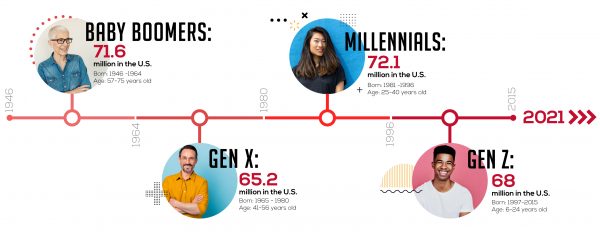At one time, marketing your brand used to be as simple as coming up with a catchy slogan and having it embraced by the masses but gone are the days of “Where’s the beef?” and “Just do it.” In today’s market, a case can be made for tailoring your marketing message to individual generations as well as investing in a multigenerational strategy. Let’s explore both options to see which might be a better fit for your next campaign.

Keep ‘Em Separated
Generational marketing can be a slippery slope. Done right, it can yield great reward. Done wrong, it can cause backlash and some very offended customers. It’s essential to take the time to understand your audience and speak to them in a way that makes your brand sound authentic. Young or old, customers will see through insincerity quickly.
Dig into your customer data. Within each generation, you can segment further and reveal essential details about your audience. Find out if your Millennial customers are buying houses and starting families or just starting their careers and worrying about student loan debt. When presenting a call to action, know the difference and present benefits that will resonate.
One Big Happy Family
You’d be surprised, but Boomers and Gen Z have a lot in common. They both are brand loyal and tend to spend more with local or independent businesses. Gen Z also tends to have similar banking habits as their parents, Gen X. In-store access and technology play a key role in spending habits across all generations. There is considerable overlap amongst every generation — this makes a strong case for a multigenerational marketing approach.
Another development of note is the rise of multigenerational households. Even before the pandemic caused widespread disruption in 2020, there was a shift. Gen Z and Millennials returned to the nest to save for their first homes. Gen X families consolidated with their Boomer parents for financial, healthcare, or childcare reasons. These condensed households allow brands to reach multiple audiences in one household, each with the ability to influence the other.
Decisions, Decisions
Here is the moment of truth. Should your brand embrace multigenerational marketing tactics, or should it adapt to a more targeted strategy? There is no right or wrong answer. It depends on what you’re selling, your budget, and what you know about your customers. Here are some key questions to ask to help determine which approach might be a better fit:
- Are the benefits of your goods or services universal?
- Will someone who is 25, 40, 55, or 70 get the same level of satisfaction in using your product?
- Can the older generations who see your marketing influence younger decision-makers and vice versa?
When in doubt, test the waters. Sample your database and try each strategy with a small campaign tied into a specific offer or landing page. Your results should reveal which of the two messages was more successful and help you determine future investment.
Not sure which direction to go, the experts at B&B Print Source can help design a direct mail marketing campaign that speaks to one, two, or all generations. We have you covered, from carefully curated and purchased lists to integrating specific copy and images onto printed collateral, packaging, signage, and direct mail based on what you know about your customers.

